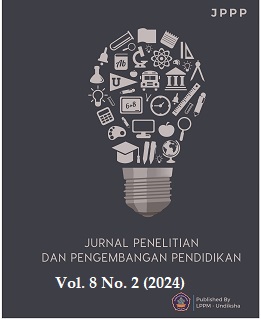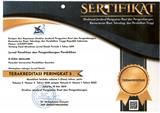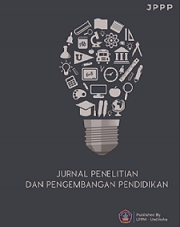Questionnaire of Natural Disaster for Mitigational Education
DOI:
https://doi.org/10.23887/jppp.v8i2.54816Keywords:
Cognitive, Affective, Conative, QuestionnaireAbstract
Mitigation knowledge is essential, especially for those who live in areas with annual disasters. Therefore, analyzing children's knowledge about mitigation is also necessary because it is the basis for preparing lessons about introducing natural disaster preparedness. This research aims to develop a questionnaire related to natural disaster preparedness based on the cognitive, affective and psychomotor domains. This research is quantitative research using a quantitative descriptive approach. The sampling method used was purposive sampling. The questionnaire development method in this research consists of several stages: itemm preparation, item selection, item sorting, and item validation. The subjects of this research were 5 lecturers, 30 students at the item preparation stage, 2 lecturers and 2 practitioners at the item selection stage, 150 elementary school students at the sorting stage, and 170 elementary school students at the validation stage. The data collection method used is cross-sectional. Then, the questionnaire was created and tested for validity and reliability. The research results show that the developed natural disaster questionnaire for mitigation education meets the requirements for validity and reliability. The research implies that this research can improve disaster mitigation education in schools.
References
Ahmad Basri, S. A., Syed Zakaria, S. A., A.Majid, T., & Yusop, Z. (2022). Exploring awareness and application of disaster risk management cycle (DRMC) from stakeholder’s perspective. International Journal of Disaster Resilience in the Built Environment, 13(4), 470–483. https://doi.org/10.1108/IJDRBE-09-2020-0105. DOI: https://doi.org/10.1108/IJDRBE-09-2020-0105
Ali, F., Russell, C., Nafeh, F., Rehm, J., LeBlanc, S., & Elton-Marshall, T. (2021). Changes in substance supply and use characteristics among people who use drugs (PWUD) during the COVID-19 global pandemic: A national qualitative assessment in Canada. International Journal of Drug Policy, 93, 103237. https://doi.org/10.1016/j.drugpo.2021.103237. DOI: https://doi.org/10.1016/j.drugpo.2021.103237
Ali, N., Alam, A., Bhat, M. S., & Shah, B. (2022). Using historical data for developing a hazard and disaster profile of the Kashmir valley for the period 1900–2020. Natural Hazards, 114(2), 1609–1646. https://doi.org/10.1007/s11069-022-05440-6. DOI: https://doi.org/10.1007/s11069-022-05440-6
Boon-Falleur, M., Grandin, A., Baumard, N., & Chevallier, C. (2022). Leveraging social cognition to promote effective climate change mitigation. Nature Climate Change, 12(4), 332–338. https://doi.org/10.1038/s41558-022-01312-w. DOI: https://doi.org/10.1038/s41558-022-01312-w
Bronfman, N. C., Cisternas, P. C., Repetto, P. B., & Castañeda, J. V. (2019). Natural disaster preparedness in a multi-hazard environment: Characterizing the sociodemographic profile of those better (worse) prepared. PLOS ONE, 14(4), 1–18. https://doi.org/10.1371/journal.pone.0214249. DOI: https://doi.org/10.1371/journal.pone.0214249
Castañeda, J. V, Bronfman, N. C., Cisternas, P. C., & Repetto, P. B. (2020). Understanding the culture of natural disaster preparedness: exploring the effect of experience and sociodemographic predictors. Natural Hazards, 103, 1881–1904. https://doi.org/10.1007/s11069-020-04060-2. DOI: https://doi.org/10.1007/s11069-020-04060-2
Chaiwan, C., Tiwong, S., Schenker, J. T., & Ramkrathok, T. (n.d.). Factors Analysis for Customer Behavior on The E-Commerce Platform in Thailand. https://doi.org/10.46254/NA07.20220557. DOI: https://doi.org/10.46254/NA07.20220557
Daud, R., & R. (2021). Face and Content Validity For The Special Education Leadership (Integration) Questionnaire In Malaysia. Turkish Journal of Computer and Mathematics Education (TURCOMAT, 12(11), 5172–5178. https://doi.org/10.17762/turcomat.v12i11.6726.
Dewi, S. P., & Kurniati, R. (2022). Revealing Cost and Benefit of Vegetative Approach to Mitigate Riverbank Landslide in Semarang Coastal Villages. IOP Conference Series: Earth and Environmental Science, 1082(1). https://doi.org/10.1088/1755-1315/1082/1/012030. DOI: https://doi.org/10.1088/1755-1315/1082/1/012030
Frantzeskaki, N., McPhearson, T., Collier, M. J., Kendal, D., Bulkeley, H., Dumitru, A., Walsh, C., Noble, K., Wyk, E., Ordóñez, C., Oke, C., & Pintér, L. (2019). Nature-based solutions for urban climate change adaptation: Linking science, policy, and practice communities for evidence-based decision-making. BioScience, 69(6), 455–466. https://doi.org/10.1093/biosci/biz042. DOI: https://doi.org/10.1093/biosci/biz042
Grassini, S., & Laumann, K. (2020). Questionnaire measures and physiological correlates of presence: A systematic review. Frontiers in Psychology, 11, 349. https://doi.org/10.3389/fpsyg.2020.00349. DOI: https://doi.org/10.3389/fpsyg.2020.00349
Han, T.-I., & Choi, D. (2019). Fashion brand love: Application of a cognition–affect–conation model. Social Sciences, 8(9), 256. https://doi.org/10.3390/socsci8090256. DOI: https://doi.org/10.3390/socsci8090256
Hasim, A. T., Guiamalon, T. S., & Boquia, A. H. (2022). Competence Of School Heads Of The Ministry Of Basic , Higher And Technical Education ( Mbhte. Bangsamoro Autonomus Region In Muslim Mindanao ( BARMM, 12(2), 61–69. https://doi.org/10.46360/globus.edu.220222010.
Hayes, A. F., & Coutts, J. J. (2020). Use Omega Rather than Cronbach’s Alpha for Estimating Reliability. But.... Communication Methods and Measures, 14(1), 1–24. https://doi.org/10.1080/19312458.2020.1718629. DOI: https://doi.org/10.1080/19312458.2020.1718629
Hutagalung, R., Permana, A. P., Uno, D. A. N., Al Fauzan, M. N., & Panai, A. A. H. (2020). Upaya Peningkatan Pengetahuan Siswa Tentang Pentingnya Mitigasi Bencana di Desa Hutamonu, Kecamatan Botumoito, Kabupaten Boalemo. Lamahu: Jurnal Pengabdian Masyarakat Terintegrasi, 1(2), 96–100. https://doi.org/10.34312/ljpmt.v1i2.15660. DOI: https://doi.org/10.34312/ljpmt.v1i2.15660
Jung, Y. (2022). Virtual Reality Simulation for Disaster Preparedness Training in Hospitals: Integrated Review. Journal of Medical Internet Research, 24(1), 1–11. https://doi.org/10.2196/30600. DOI: https://doi.org/10.2196/30600
Kawasaki, H., Yamasaki, S., Yamakido, M., & Murata, Y. (2022). Introductory Disaster Training for Aspiring Teachers: A Pilot Study. Sustainability, 14(3492), 1–12. https://doi.org/10.3390/su14063492. DOI: https://doi.org/10.3390/su14063492
Krongthaeo, S., Partiprajak, S., & Piaseu, N. (2022). Psychometric properties of the Disaster Preparedness Evaluation Tool (DPET) Thai version among Thai registered nurses. International Journal of Disaster Risk Reduction, 76(December 2021), 102987. https://doi.org/10.1016/j.ijdrr.2022.102987. DOI: https://doi.org/10.1016/j.ijdrr.2022.102987
Kurata, Y. B., Prasetyo, Y. T., Ong, A. K. S., Nadlifatin, R., Persada, S. F., Chuenyindee, T., & Cahigas, M. M. L. (2022). Determining factors affecting preparedness beliefs among Filipinos on Taal volcano eruption in Luzon, Philippines. International Journal of Disaster Risk Reduction, 76, 103035. https://doi.org/10.1016/j.ijdrr.2022.103035. DOI: https://doi.org/10.1016/j.ijdrr.2022.103035
Lamm, K. W., Lamm, A. J., & Edgar, D. (2020). Scale Development and Validation: Methodology and Recommendations Scale Development and Validation: Methodology and Recommendations. Journal of International Agricultural and Extension Education, 27(2), 24–35. https://doi.org/10.4148/2831-5960.1115. DOI: https://doi.org/10.4148/2831-5960.1115
Li, H., Shang, W., Adams, B., Sayagh, M., & Hassan, A. E. (2021). A Qualitative Study of the Benefits and Costs of Logging From Developers’ Perspectives. IEEE Transactions on Software Engineering, 47(12), 2858–2873. https://doi.org/10.1109/TSE.2020.2970422. DOI: https://doi.org/10.1109/TSE.2020.2970422
Mailisa, F., & Idami, Z. (2022). Peran Keuchik Dalam Mitigasi Bencana Banjir Di Gampong Luthu Dayah Krueng, Kecamatan Sukamakmur, Kabupaten Aceh Besar. Jurnal Ilmiah Mahasiswa Fakultas Ilmu Sosial & Ilmu Politik, 7(2). https://doi.org/https://jim.usk.ac.id/FISIP/article/view/20190.
Meliana, D., Suharini, E., & Sanjoto, T. (2020). The Profile Of Disaster Mitigation Literacy Ability By Students In The School Prone To Tidal Floods. Proceedings of the 5th International Conference on Science, Education and Technology, ISET 2019. DOI: https://doi.org/10.4108/eai.29-6-2019.2290314
Muhtar, I., & Meiwanda, G. (2022). Mitigasi Bencana Abrasi Pantai Di Desa Permai Kecamatan Rangsang Barat Kabupaten Kepulauan Meranti. JURNAL HUKUM, POLITIK DAN ILMU SOSIAL, 1(4), 60–65. https://doi.org/10.55606/jhpis.v1i4.640. DOI: https://doi.org/10.55606/jhpis.v1i4.640
Raharjanti, N. W., Wiguna, T., Purwadianto, A., Soemantri, D., Indriatmi, W., Poerwandari, E. K., Mahajudin, M. S., Nugrahadi, N. R., Roekman, A. E., Saroso, O. J. D. A., Ramadianto, A. S., & Levania, M. K. (2022). Translation, validity and reliability of decision style scale in forensic psychiatric setting in Indonesia. Heliyon, 8(7), 9810. https://doi.org/10.1016/j.heliyon.2022.e09810. DOI: https://doi.org/10.1016/j.heliyon.2022.e09810
Rahmawati, D., & Fatmawati, S. (2022). Hubungan Pengetahuan dengan Sikap Kesiapsiagaan Bencana Banjir di Desa Koripan Kecamatan Polanharjo Kabupaten Klaten. SEHATMAS: Jurnal Ilmiah Kesehatan Masyarakat, 1(4), 513–522. https://doi.org/10.55123/sehatmas.v1i4.892. DOI: https://doi.org/10.55123/sehatmas.v1i4.892
Septaria, K., & Dewanti, B. A. (2021). Implementation of project based learning on student reasoning on COVID-19 disaster mitigation. Prisma Sains: Jurnal Pengkajian Ilmu Dan Pembelajaran Matematika Dan IPA IKIP Mataram, 9(1), 20–27. https://doi.org/10.33394/j-ps.v9i1.2951. DOI: https://doi.org/10.33394/j-ps.v9i1.2951
Valtonen, L., & Mäkinen, S. J. (2022). Advancing Reproducibility and Accountability of Unsupervised Machine Learning in Text Mining: Importance of Transparency in Reporting Preprocessing and Algorithm Selection. Organizational Research Methods, 0(0), 1–26. https://doi.org/10.1177/10944281221124947. DOI: https://doi.org/10.1177/10944281221124947
Veronica, M., Rameck, D., Makomborero, M., & Rungano, M. (2022). Enhancing disaster risk reduction through adoption of climate smart initiatives in marginal communities of southern Zimbabwe. Environmental Challenges, 9(September), 100637. https://doi.org/10.1016/j.envc.2022.100637. DOI: https://doi.org/10.1016/j.envc.2022.100637
Wahyuni, S. (2018). CAC Model to Evaluate Teachers’ Attitudes towards Technology Use in Their EFL Classrooms. Language Circle: Journal of Language and Literature, 13(1). https://doi.org/10.15294/lc.v13i1.16659.
Wang, J.-J., & Tsai, N.-Y. (2022). Factors affecting elementary and junior high school teachers’ behavioral intentions to school disaster preparedness based on the theory of planned behavior. International Journal of Disaster Risk Reduction, 69, 102757. https://doi.org/10.1016/j.ijdrr.2021.102757. DOI: https://doi.org/10.1016/j.ijdrr.2021.102757
Wardaya, N. F., & Ma, A. (2021). The Student ’ s Knowledge of Volcanic Eruption Mitigation in Magelang Regency. Atlantis Press, 541(Isse 2020), 669–674. https://doi.org/10.2991/assehr.k.210326.097. DOI: https://doi.org/10.2991/assehr.k.210326.097
Wulandari, F., Aryani, L., & Mahawati, E. (2022). Literasi Informasi dan Perilaku Kesehatan Terhadap Pencegahan Penularan Covid-19 pada Siswa SD Sekayu Semarang. Abdimasku: Jurnal Pengabdian Masyarakat, 5(2), 215–222. https://doi.org/10.33633/ja.v5i2.582. DOI: https://doi.org/10.33633/ja.v5i2.582
Downloads
Published
How to Cite
Issue
Section
License
Copyright (c) 2024 Muhsinah Annisa, Fadhlan Muchlas Abrori, Asrani Asrani, Teguh Prasetio, Herti Prastitasari

This work is licensed under a Creative Commons Attribution-ShareAlike 4.0 International License.
Authors who publish with the Jurnal Penelitian dan Pengembangan Pendidikan agree to the following terms:
- Authors retain copyright and grant the journal the right of first publication with the work simultaneously licensed under a Creative Commons Attribution License (CC BY-SA 4.0) that allows others to share the work with an acknowledgment of the work's authorship and initial publication in this journal.
- Authors are able to enter into separate, additional contractual arrangements for the non-exclusive distribution of the journal's published version of the work (e.g., post it to an institutional repository or publish it in a book), with an acknowledgment of its initial publication in this journal.
- Authors are permitted and encouraged to post their work online (e.g., in institutional repositories or on their website) prior to and during the submission process, as it can lead to productive exchanges, as well as earlier and greater citation of published work. (See The Effect of Open Access)








